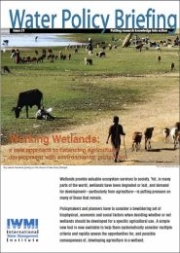Working Wetlands: a new approach to balancing agricultural development with environmental protection.
Citation:
International Water Management Institute (IWMI) 2006. Working wetlands: a new approach to balancing agricultural development with environmental protection. Colombo, Sri Lanka: International Water Management Institute (IWMI) 6p. [IWMI Water Policy Briefing 21]
Abstract
This Water Policy Briefing is based on Working Wetlands: Classifying Wetland Potential for Agriculture by Matthew P. McCartney, Mutsa Masiyandima and Helen A. Houghton-Carr (IWMI Research Report 90); Wetlands: Functions and Values by Matthew P. McCartney; and Challenges for Wetlands: Water Management and Agriculture by Max Finlayson, Mutsa Masiyandima, David Molden and Rebecca Tharme. The trade-off between environmental protection and development is most acute in dynamic and complex ecosystems such as wetlands. Wetlands work’ for society. They maintain environmental quality, sustain livelihoods and support biodiversity. However, socio-economic pressures mean that we are now pushing wetlands to work even harder, for example, by producing more crops or grazing more cattle. History shows that ‘over-working’ wetlands can cause them to change significantly–often with negative effects on the communities or even civilizations that depend on them. Safeguarding the benefits of wetland services for society must be weighed against the potential benefits of development. But making such decisions is difficult. Besides physical, economic and social factors, the impact of any changes on stakeholders at all levels–local, regional and global–must be considered for wise use’ of wetlands. policymakers and planners need to ensure that they take the most comprehensive range of factors possible into account in any trade-off between wetland services and development choices. Fortunately, a simple sixstep approach to determine Working Wetland Potential is now available to help assess the opportunities and risks of changing a wetland’s workload (Fig. 1). This method, one of the first of its kind, combines both the social and biophysical aspects of wetlands into one index relevant to agricultural use. IWMI has applied the approach to proposed agricultural activities in wetlands in southern Africa–a region where development is essential and pressure on wetlands is increasing. The approach ensures that many crucial questions about using wetlands for agriculture are made explicit and, at least, considered in the planning process. It is a step forward in securing and improving people’s quality of life while, at the same time, safeguarding the ecological benefits derived from wetland ecosystems.


